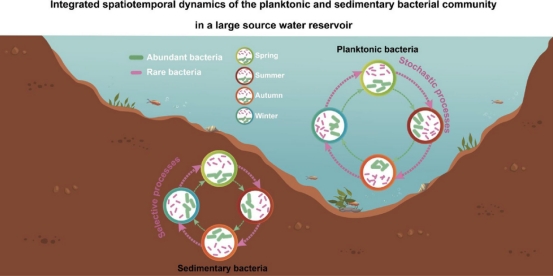QingmiaoYu, XiandaHu, FuzhengZhao, ChenyuZhu, LinchangGuan, HongqiangRen, JinjuGeng. Rare biosphere regulates the planktonic and sedimentary bacteria by disparate ecological processes in a large source water reservoir. Water Research, 2022, 118255. https://doi.org/10.1016/j.watres.2022.118255
Highlights
• Providing integrated spatiotemporal dynamics of planktonic and sedimentary bacteria
• Planktonic not sedimentary bacteria exhibited obvious spatiotemporal variations
• Sedimentary bacteria possessed higher biodiversity and a more complex network
• Rare rather abundant taxa dominantly determined microbial spatiotemporal succession
• Randomness and selection respectively controlled rare biosphere in water and sediment
Abstract: The bacteria in the water column and surface sediments are inherently intertwined and inseparable in aquatic ecosystems, yet little is known about the integrated spatiotemporal dynamics and driving mechanisms of both planktonic and sedimentary bacterial communities in reservoirs. By investigating the planktonic and sedimentary bacteria during four seasons from 88 samples of 11 representative sites across the Danjiangkou reservoir, we depicted an integrated biogeographic pattern of bacterial communities in the water source of the world's largest water diversion project. Our study revealed both planktonic (mantel r = 0.502, P = 0.001) and sedimentary (mantel r = 0.131, P = 0.009) bacterial communities were significantly correlated with environmental heterogeneity, but a weak disparity along spatial heterogeneity, and the significant seasonal dynamics of planktonic (mantel r = 0.499, P = 0.001) rather than sedimentary bacteria. Particularly, rare biosphere played a main role in determining the community succession in the reservoir. It not only exhibited a more striking environmental separation than abundant taxa but also was an essential part in mediating spatiotemporal shifts of planktonic bacteria and maintaining the stability of bacterial community. These rare bacteria were respectively mediated by stochastic (62.68%) and selective (79.60%) processes in water and sediments despite abundant taxa being largely determined by stochastic processes (86.88%−93.96%). Overall, our study not only fills a gap in understanding the bacterial community dynamics and underlying drivers in source water reservoirs, but also highlights the particular importance of rare bacteria in mediating biogeochemical cycles in world's large reservoir ecosystems.
Keywords: Source water reservoir,bacterial community,rare biosphere,spatiotemporal dynamic
